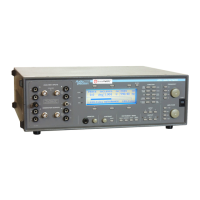All of the numerical step choices count the number of steps of the
swept parameter, not the number of data points on the graph. The
number of data points will always be one more than the number of
steps.
For all step types except EXTERNAL, the upper right soft key selects
the speed of the sweep. The choices are FAST, MEDIUM, and SLOW.
FAST is the appropriate choice when testing devices without significant
delay between the input and output. Amplifiers, mixing consoles, and
equalizers are examples of devices that can generally be tested in FAST
mode. If the input-to-output delay is more than about 200 ms, FAST
mode should not be used.
MEDIUM sweep speed inserts a time delay of approximately 0.9 sec
after changing the generator setting, before the analyzer begins taking
data. Its principal intent is for use on a ATS-1 Access generator
feeding an audio transmission link while the analyzer section of
another Portable makes EXTERNAL sweep measurements at the
receiving end. It can also be used for devices with a moderate delay,
such as a satellite relay or an analog tape recorder with a moderate
amount of delay between the record and reproduce heads, or for
recording test tapes for external response measurements.
SLOW sweep speed inserts a minimum delay of three seconds after
changing the generator setting before the analyzer begins taking data.
This can be used for very slow transmission links or analog tape
recorders with long delays between recording and reproducing heads.
It is also important for external measurements that require automatic
tuning of the tunable filter (XTALK and THD+N in autotuning mode)
before obtaining a valid reading, because extra time must be taken for
the frequency reading and filter tuning. It is also intended for
recording test tapes for external XTALK and THD+N measurements.
The SLOW setting is always the most reliable; if you are unsure of the
time required by your device and measurement, start with SLOW
sweep speed. Assuming the data is reasonable, bump the speed up to
MEDIUM and compare. If the data is approximately the same, you
may step up to MEDIUM, and may also want to try FAST.
4 Functions
Sweeps Function Descriptions
4-44 ATS-1Access User's Manual

